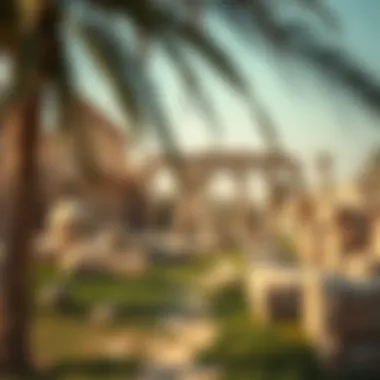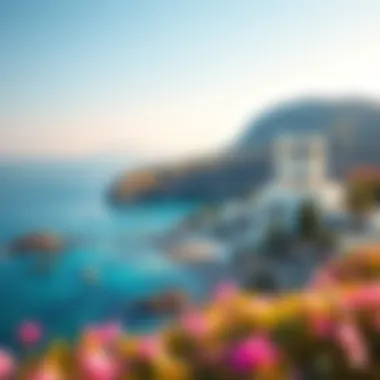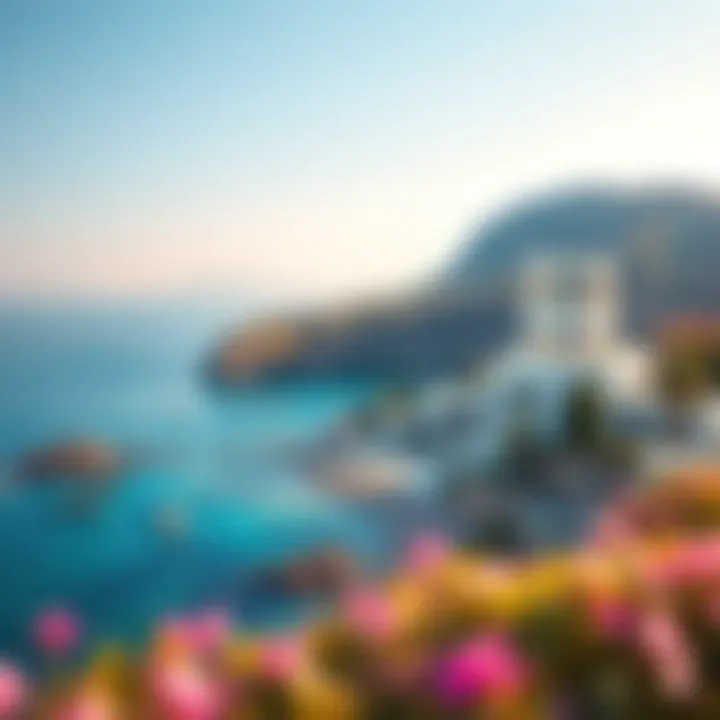Discover Nearby Attractions: Travel Beyond the UAE


Intro
When you're living in the dynamic cradle of innovation that is the United Arab Emirates, it's easy to fall into the rhythm of its vibrant cities. But step outside the bustling metropolis of Dubai or the capital's stately Abu Dhabi, and you just might find a world rich in history, culture, and natural beauty waiting to be explored. This guide serves as a beacon for those seeking adventure and enrichment in the nearby regions, where experiences are plentiful and landscapes diverse.
In this article, we navigate through some scintillating locations on the periphery of the UAE, showcasing not just the sights but also the stories behind them. Like a well-worn map revealing hidden treasures, we aim to chart a course through cultural enclaves, ancient ruins, and majestic natural wonders.
Why venture beyond? Because while the UAE boasts awe-inspiring attractions, its neighboring destinations offer a refreshing palette of experiences that often go unnoticed. Picture a tranquil sunset by the shores of Oman or ancient forts dotting the landscapes of Bahrain—each place stands as a testament to the region’s rich tapestry of history and culture.
In the coming sections, we will detail the various spots worth visiting, provide essential information about each location, and suggest activities that appeal to different kinds of travelers: those hungry for cultural immersion and those eager for a relaxing escape. Whether you're a history buff eager to walk the paths of the ancients or a nature lover looking to breathe in fresh mountain air, our exploration will guide you toward remarkable experiences just a stone's throw from the UAE.
Preamble to Regional Travel
Traveling beyond one's borders is not merely a leisure activity; it stands as a gateway to understanding cultures, histories, and lifestyles that are different from one's own. For residents of the UAE, regional travel opens up a cornucopia of experiences, enriching their lives and broadening perspectives. This article delves into the significance of exploring nearby destinations, particularly focusing on the unique benefits and aspects that come with this exploration.
Significance of Exploration Beyond Borders
Understanding foreign lands feeds curiosity and sparks an appreciation for diversity. When exploring nearby territories, travelers not only engage with local traditions and practices but also delve into the everyday lives of people who inhabit them. For instance, a short drive from Dubai could transport a traveler to the serene mountains of Oman, where a simple cup of coffee turns into a cultural ritual, steeped in history and warmth.
Exploring beyond borders serves various purposes:
- Cultural Exchange: It fosters deeper connections between cultures, facilitating dialogues that enrich personal and communal identities.
- Historical Insight: Visiting historical sites brings history to life, enabling visitors to experience the stories that shaped regions.
- Natural Wonders: Many neighboring countries boast breathtaking landscapes that contrast sharply with the urbanity of the UAE, inviting adventure enthusiasts to relish in outdoor escapades.
Traveling also enhances personal growth. It encourages adaptability, engenders problem-solving skills, and nurtures empathy toward diverse ways of living. Think of the delightful randomness of stumbling upon an artisanal market in Bahrain; such moments can be transformative, exposing visitors to new ideas and inspirations.
Understanding the Emirati Travel Landscape
The Emirati travel landscape is quite distinctive. With diverse nationalities residing and working in the UAE, many expatriates find themselves more inclined to explore the nearby gems rather than journeying to distant lands. The ease of access to neighboring countries like Oman, Saudi Arabia, and Bahrain has turned regional travel into a pragmatic choice.
Given that the UAE is a melting pot composed of various cultures, it naturally prepares its residents for traversing new lands. Moreover, recent initiatives by the UAE government have aimed to encourage tourism in nearby regions, strengthening ties while promoting a mutual understanding of heritage and local customs.
Some key components influencing the Emirati travel landscape include:
- Accessibility: Well-maintained roads and affordable flights make short trips achievable. Things like proximity play a crucial role in travel decision-making today.
- Cultural Programs: Events and festivals celebrating regional heritage are often advertised, sparking interest among locals who wish to connect with the history and culture of the places they are visiting.
- Shared Histories: The Gulf Cooperation Council nations share cultural, linguistic, and economic ties, making regional travel a seamless experience.
Oman: A Cultural Gem
Oman, nestled on the southeastern coast of the Arabian Peninsula, is rich in cultural heritage and natural beauty. This country stands out in the region for its welcoming atmosphere, historic marvels, and a landscape that tells a story of its own. Traveling to Oman enhances one’s appreciation for the diversity that surrounds the UAE while offering unique experiences that blend tradition with modern conveniences. Tourists looking for a genuine cultural experience will find Oman an ideal destination.
Muscat: Where History Meets Modernity
Exploring the Sultan Qaboos Grand Mosque
The Sultan Qaboos Grand Mosque is not just the largest mosque in Oman; it symbolizes the country’s dedication to faith and community. This architectural wonder features intricate designs and is adorned with vibrant artwork, making it a visual feast. The mosque's key feature is its stunning chandelier, one of the largest in the world, which hangs elegantly in the main prayer hall.
Visiting the mosque is a unique opportunity to connect with local culture, as it welcomes visitors irrespective of their background. It offers a tranquil place for reflection and admiration of Islamic art, making it a perfect stop for tourists seeking both beauty and reverence while exploring the highlights of Muscat.
"The Sultan Qaboos Grand Mosque is not just an architectural gem; it is a beacon of Oman's commitment to inclusivity and education.”
Discovering the Royal Opera House
The Royal Opera House in Muscat is a hub of artistic expression. It's not merely a venue but a gateway to Oman's cultural renaissance. This extravagant building showcases international performances, from opera to ballet, making it a pivotal aspect of the country’s cultural scene. Key characteristics include its impressive façade, adorned with Arabic calligraphy and intricate tiles that reflect the local culture.
For arts enthusiasts, catching a performance here is an enriching experience, as it highlights the blend of tradition and modernity. Despite its more modern function, the building harmoniously fits into Muscat’s historical landscape. Thus, including the Royal Opera House in your visit allows for an exploration of Oman's commitment to the arts within a culturally rich context.
Cultural Experiences in Mutrah Souq
Mutrah Souq represents an authentic slice of Omani culture. This bustling marketplace is famous for its traditional crafts, spices, and textiles. Walking through the narrow lanes, you will find everything from silver jewelry to ornate khanjars (traditional daggers). The souq is more than just a shopping district; it is a vital part of Omani life, showcasing the daily activities and traditions of its people.


Key attractions in the souq include the friendly vendors, who share stories about their crafts, and various stalls offering local delicacies. The vibrant atmosphere makes it a beneficial choice for visitors keen on immersing themselves in local culture while shopping for unique souvenirs. However, be prepared to haggle, as it is a part of the experience here.
Nizwa: The Heart of Oman
Nizwa Fort and Its Historic Significance
Nizwa Fort is a prominent historical site that embodies Oman's architectural and cultural legacy. With its towering walls and expansive courtyards, the fort stands as a reminder of the Omani people’s valor in defending their land. A key characteristic of Nizwa Fort is its massive circular tower, which offers breathtaking views of the surrounding landscape and the date palms that stretch as far as the eye can see.
The fort's historical significance lies not just in its defensive function but also in its role as a center of governance and trade. Visiting Nizwa Fort provides an enlightening perspective on how Omani society developed over centuries, making it an important destination for anyone interested in history and culture.
Local Markets and Craftsmanship
The local markets surrounding Nizwa are rich in craftsmanship, offering a variety of traditional products, including pottery and textiles. This aspect of Nizwa allows visitors to engage with artisans who have honed their skills over generations. Key features of these markets include the vibrant colors and patterns evident in handicrafts that reflect Omani culture.
Visitors can interact directly with the artisans, making it a rewarding experience. Buying directly from the source not only supports local economies but also provides insights into the artistry that defines Oman's heritage. However, keep in mind that the intricacies of craftsmanship require an eye for quality, ensuring that your selections truly represent the spirit of Oman.
Mountains and Natural Attractions
Oman's rugged mountains offer breathtaking natural attractions that contrast the urban landscapes of Muscat. The Hajar Mountains are not only visually striking but serve as a backdrop for many outdoor adventures such as hiking, rock climbing, and exploring remote villages. A key characteristic of these mountains is their unique geology, with deep canyons and stunning vistas that attract nature lovers.
Engaging with nature in Oman presents an opportunity to disconnect from city life and enjoy tranquility. However, adventurers should consider the weather conditions and terrain challenges, ensuring they are well-prepared for their excursions. Enjoying the mountains of Oman complements the cultural journey and offers a different layer of appreciation for the country’s geography.
Saudi Arabia: Unveiling the Kingdom
Saudi Arabia is more than just desert and camels; it holds a wealth of history, modern marvels, and cultural significance just waiting to be explored. For travelers originating from the United Arab Emirates, this kingdom serves as an enticing destination due to its unique blend of ancient heritage and contemporary advancements. The juxtaposition of the bustling modern cities like Riyadh with the timeless landscapes of AlUla and its archaeological treasures offers a diverse itinerary that appeals to those looking for both leisure and education. As a traveler, engaging with Saudi Arabia’s offerings opens a door to understand the region’s pivotal role in Islamic history and its burgeoning position in modern geopolitics.
Riyadh: The Modern Capital
Visiting the National Museum
The National Museum in Riyadh holds a mirror to the rich history and cultural evolution of Saudi Arabia from prehistoric times to the present. One of its most important features is its thoughtful exhibitions that beautifully weave artifacts and narratives together, providing not just a showcase of historic items, but a contextual understanding of how these pieces fit into the vast tapestry of Saudi identity. Visitors often find themselves captivated by the interactive displays that make history come alive, especially for those keen on delving into the sociopolitical influences that have shaped the region.
This museum is a top-notch choice for any itinerary due to its comprehensive nature; it adeptly balances scholarly information with engaging storytelling, catering to both light enthusiasts and serious scholars alike. The unique aspect of the National Museum is its architectural beauty, which itself is a landmark worth exploring. One downside to consider is the potential for crowding during weekends, which could dilute the experience for some.
Exploring Diriyah and Its Cultural Heritage
Diriyah stands as a testament to the kingdom's historical significance and vibrant culture. This area, once the original home of the Saudi royal family, is deeply embedded in the narrative of national identity. A stroll through the restored mud-brick buildings of Al-Turaif offers an enchanting glimpse into the life of the 18th-century settlements. Visitors are often taken aback by its architectural style, reflective of the region’s traditional Najdi craftsmanship.
Diriyah is valuable not just for its aesthetics but also for its rich history, which can be explored through guided tours that narrate the events that unfolded in those very streets. Its unique feature is the intertwining of history and community life; Diriyah is a living museum that buzzes with activities and cultural events. A downside is the limited signage and tourist facilities, which may pose challenges for solo adventurers unfamiliar with the locale.
AlUla: A Testament to History
Madain Saleh: An Ancient City
Madain Saleh, a UNESCO World Heritage site, emerges as one of Saudi Arabia’s crown jewels in terms of historical significance. The spectacular rock-cut tombs dating back to the Nabatean era are striking not just in their artistry but also in their elaborate engineering. Visitors are often left awe-struck by the sheer scale and preservation of these structures, which serve as a rough echo of Petra, though less commercialized, offering an intimate experience with history.
The appeal of Madain Saleh lies in its blend of breathtaking landscapes and archaeological depth, making it an ideal spot for both sightseers and history buffs. The unique aspect of this ancient city is the combination of natural beauty with archaeological intrigue, although warnings about the harsh climate should be heeded by travelers planning a spring visit.
Exploring the Rock Formations
Not only do the historical sites of AlUla draw crowds, but the surreal rock formations also captivate the imagination. These naturally sculpted rocks appear almost otherworldly, inviting photography enthusiasts and adventurers alike to lose themselves in nature's artistry. The contrasting hues and shapes provide a striking backdrop for both casual strolls and intense hikes.
What makes exploring these formations particularly appealing is the range of activities available, from thrilling rock climbing to serene nature walks. Each formation presents unique narratives shaping the local folklore, offering deeper context for those willing to listen. However, trekking in some areas can require a fair amount of stamina and preparation, which may not appeal to all visitors.
Saudi Arabia’s vast landscape and rich heritage beckon travelers from the UAE, not merely for close proximity, but for the life-changing experiences it promises.
Bahrain: An Eclectic Experience
Bahrain is often a hidden gem, tucked away in the Persian Gulf, combining modernity with rich traditions. Its strategic location near the UAE makes it an attractive option for quick getaways. The blend of Arab and Persian cultures here creates a unique tapestry that travelers find intriguing. This destination offers more than just scenic views; it provides insights into a vibrant social fabric. Whether you are drawn by history, culture, or a mix of both, Bahrain has something to offer.


Manama: A Cultural Hub
Visiting the Bahrain National Museum
The Bahrain National Museum serves as a portal into the depths of Bahraini heritage. It stands out for its extensive collection of historical artifacts and artworks, which showcase the island's storied past. Walking through, visitors find themselves immersed in a narrative woven throughout centuries, from ancient Dilmun civilization artifacts to contemporary pieces that resonate with local culture.
One of the most striking features of this museum is its architectural design, which itself tells a story. The clever use of space allows for a natural flow from one exhibit to another. This structure not only enhances the visitor experience but also reflects Bahrain’s commitment to preserving its cultural identity. The museum's frequent workshops and exhibitions further provide opportunities for visitors to engage with local artists and historians, creating a dynamic cultural environment. For those seeking to broaden their understanding of Bahrain, visiting this museum is an enriching experience.
Bahrain Fort: A UNESCO World Heritage Site
Bahrain Fort, recognized by UNESCO, stands as a testament to the island’s historical significance. The fort’s strategic location and architectural brilliance make it a focal point for both history buffs and casual visitors. It dates back to around 2300 BC and interacts with various eras of rule, including the Portuguese and the Ottomans, which adds layers to its historical narrative.
Not only is the fort an impressive sight, but it also encompasses various archaeological sites that provide insight into Bahrain's past societies. The panoramic views of the surrounding area from the fort's walls are particularly mesmerizing during sunset, making it a popular spot for photography. However, the fort does have its challenges; at times, the infrastructure might not accommodate all visitors smoothly. Still, the historical journey it offers outweighs the drawbacks, positioning Bahrain Fort as a must-visit site for any traveler.
The Tree of Life: Nature’s Mystery
The Tree of Life, a solitary tree rising from the arid landscape, sparks curiosity and wonder. Positioned in the middle of the harsh desert, it stands tall at around 9.75 meters, seemingly without any visible source of water. This tree has thrived for many years, capturing both the hearts and minds of those who make the trip.
Its uniqueness lies not just in its survival but also in the legends surrounding it, which instill a sense of mystery. Many people travel to see if they, too, can unravel the logic behind its resilience. For those interested in the natural world, this tree represents an extraordinary aspect of ecological adaptation. While the area lacks extensive tourist facilities, visiting the Tree of Life can become a profound experience, offering quiet reflection away from the hustle and bustle of city life.
Whether experiencing the hustle of Manama’s streets or marveling at the peacefulness of the Tree of Life, Bahrain's eclectic offerings provide invaluable insights and memorable experiences, perfectly complementing the travel narrative for those exploring nearby destinations.
Qatar: A Blend of Tradition and Innovation
Qatar's rapid transformation from a pearl-trading nation to a modern economic powerhouse showcases its unique blend of tradition and innovation. For tourists seeking a meaningful experience, understanding this duality enriches their journey. This small yet dynamic nation is a prime illustration of how traditional customs can coalesce with contemporary advancements, making it an excellent destination for exploration.
Doha: A Rising Tourist Destination
Doha has emerged as a vibrant city that seamlessly balances progressive urban development with rich cultural heritage. The capital is a gateway to Qatar's historical treasures and modern luxuries, drawing in tourists from all over the world. As a cultural hub, Doha offers sights and experiences that are truly one-of-a-kind.
Exploring the Museum of Islamic Art
The Museum of Islamic Art is a key feature in Doha's cultural landscape. It is often recognized for its striking architectural design, inspired by traditional Islamic motifs. The museum houses an extensive collection of Islamic artifacts, which spans over 1,400 years and includes items from three continents. This museum's contribution to the overall theme of cultural exploration cannot be overstated.
Visitors are often enchanted by its serene surroundings and the stunning views of the Doha skyline from the waterfront park. The Museum is not just a collection of artifacts; it serves as a place for education and appreciation of Islamic culture. One noteworthy characteristic is how it combines art with history, offering insight into the influences of Islamic civilization.
The educational programs and exhibitions provide benefits to those eager to deepen their understanding of the Islamic world. However, the vastness of its collections may feel overwhelming to some; it's easy to miss nuanced details without proper guidance. Nevertheless, for those prepared to engage deeply, the museum offers a rewarding experience that aligns perfectly with our goal of understanding regional nuances.
Souq Waqif: A Taste of Local Life
Souq Waqif offers a genuine glimpse into Qatari life, making it a popular destination for tourists who wish to savor the local culture. This bustling market is filled with shops selling spices, textiles, and traditional handicrafts alongside restaurants serving authentic Qatari cuisine. A key defining feature of Souq Waqif is its lively atmosphere, which brings together locals and tourists alike.
Visitors can engage in open-air dining while listening to traditional music, giving them a taste of how community and hospitality intertwine in Qatari culture. The arrangement of the market, with its winding alleyways and vibrant stalls, allows for exploration and discovery, creating a unique experience that varies from one visit to the next. However, due to its popularity, the souq can become crowded, which might detract from its charm for some. Despite this, the vibrancy and accessibility of local life make Souq Waqif a must-visit spot in the region.
Al Zubarah: A Historical Insight
Al Zubarah stands as a testament to Qatar’s rich history, showcasing its importance in regional trade and cultural development. The site has been recognized as a UNESCO World Heritage Site, drawing those interested in the historical aspects of Qatar. Its significance goes beyond mere antiquity; it tells a story of a once-flourishing town that played a crucial role in the Gulf's maritime trade.
Understanding the Archeological Site
The archeological site at Al Zubarah includes the ruins of what was once a bustling trading port. The remains of the buildings, streets, and fortifications reveal much about the social and economic life of its time. A key characteristic is how well-preserved many structures are, allowing visitors to visualize the layout of this ancient community.
By immersing oneself in the site, visitors gain insights into the lives of those who inhabited Al Zubarah, enriching their understanding of Qatar's history. However, the more isolated location may pose challenges in terms of accessibility for some tourists. Yet, for those willing to venture off the beaten path, the rewards of exploration are significant.
Exploring the Fortification
The fortification of Al Zubarah is another critical aspect for history enthusiasts. Standing prominently, the fort provides a unique perspective on the military architecture of the region and showcases the strategies employed during its operational years. Its sheer walls and design reflect the historical context of its construction, representing power and protection.
The fort's accessibility permits visitors to explore its interior, offering an intimate look at the space where vital decisions were made. The panoramic views from its walls also provide a contrast between the rugged landscape and modern-day developments in the surrounding areas. While exploring robust historical sites like these requires some effort, the sheer significance and visual dynamism make it an unforgettable part of Qatar's narrative.


“Travel is about the transformative experience, where history meets the present in remarkable ways.”
Engaging with Qatar as a destination allows for a rich exploration where tradition intertwines seamlessly with innovation, providing travelers with experiences that resonate long after their visit.
Exploring Nature: The Great Outdoors
Exploring nature offers a plethora of benefits, especially for those in the UAE looking to step beyond the urban landscape and immerse themselves in the beauty of the natural world. This section highlights the value of outdoor adventures, not just for leisure but for broadening one’s perspective of the region. Given that the UAE is often perceived primarily for its skyscrapers and luxury malls, the natural landscapes around—such as mountains, lakes, and heritage sites—can be overshadowed. However, these outdoor spots hold tremendous cultural and ecological significance, allowing visitors to connect with heritage and environment while engaging in outdoor pursuits.
Hatta: A Hidden Oasis
Adventure in Hatta Dam
Hatta Dam stands out as a prime location for adventure lovers and families alike. Its most notable aspect is the wide range of water sports available, such as kayaking and paddleboarding. The vibrant turquoise water, surrounded by rugged mountains and lush greenery, creates a picturesque setting that invites relaxation amidst excitement. This dam is especially popular due to its accessibility; just a short drive from the bustling heart of Dubai, it’s an easy getaway for those looking to break from the routine.
Though it offers a wealth of recreational opportunities, adventurers should be mindful of certain considerations. The weather can turn quite warm, especially during summer months, making early morning or late afternoon visits more appealing. Additionally, while equipment rentals are available, planning ahead can ensure a smooth experience.
Hatta Dam's unique feature is undoubtedly its stunning landscape. The experience of navigating through the calm waters, with the dawn or dusk creating a mesmerizing play of colors on the mountains, adds a layer of tranquility and beauty that is difficult to replicate.
"Hatta Dam is truly the best of both worlds – exhilarating experiences with natural wonder wrapped around it."
Discovering Hatta Heritage Village
Hatta Heritage Village provides a distinct glimpse into the UAE's past, merging education with leisure seamlessly. The village is constructed to mimic traditional Emirati homes, showcasing how locals lived in earlier times. What makes it particularly captivating is the interactive element; visitors engage in various activities such as weaving and pottery, which helps preserve these age-old traditions. This immersion connects the visitors not only to the history but also to the cultural fabric of the nation.
The key characteristic here is undoubtedly the preservation of local history. Hatta Heritage Village stands as a testament to the enduring legacy of Emirati culture, which many travelers find inspiring and enlightening. Furthermore, its location in Hatta links it with the surrounding natural beauty, creating a full-day experience where nature lovers and cultural aficionados alike can thrive.
Among the unique features, the view from the heritage site presents a beautiful backdrop of the Hajar Mountains, enriching the experience. However, it's essential for visitors to be respectful of the culture represented here and ensure they follow guidelines set by the village staff. This sensitivity contributes positively to the experience and further enhances understanding and appreciation of the heritage.
Ras Al Khaimah: Natural Wonders
Exploring Jebel Jais
Jebel Jais is known as the highest peak in the UAE and boasts unrivaled panoramic views that entice hikers and thrill-seekers. The allure of Jebel Jais lies in its dramatic cliffs and stunning vistas, making it a popular spot for outdoor enthusiasts eager for both adventure and breathtaking scenery. Its unique characteristic is the long zipline, which allows visitors to soar through the air at incredible speeds while taking in the remarkable landscape below. This zipline has gained a reputation for being one of the longest in the world, drawing in adrenaline junkies from all over.
Besides adventure, Jebel Jais serves as an ecological treasure, providing habitats for mountain wildlife. However, the rugged terrain means that preparation is important; wildlife is best observed in the early mornings or late afternoons when temperatures are more tolerable and animals are more active.
Beach Activities and Desert Experiences
Ras Al Khaimah offers a medley of both beach and desert activities that provide a comprehensive experience of the UAE's diverse environments. The beaches are a perfect setting for relaxation, snorkeling, and water sports, while the nearby desert allows for thrilling desert safaris, dune bashing, and camel rides. This dual offering allows for a balanced exploration of coastal and arid landscapes, catering to a range of interests.
Moreover, the unique beaches here offer a quieter alternative to some of the busier resorts in the UAE, providing a more intimate experience with softer sands. For those who prefer the desert, the multitude of excursions available provides not only adventure but also a chance to marvel at stunning sunsets over the dunes. On the flip side, travelers must consider that desert heat can be intense; early morning and late afternoon activities are advisable.
Ending
Choosing the Right Destination
When pondering over nearby travel options resonating with the richness of culture, history, and natural beauty, it’s paramount to assess your interests and priorities. Picking the right destination can significantly enhance your travel experience. Think about whether you are drawn to historical landmarks, adventure in nature, culinary exploration, or vibrant urban life. Each destination brims with its unique offerings that cater to varied tastes and preferences.
Understanding personal inclinations plays a vital role. For instance, if ancient architecture and cultural immersion tickle your fancy, Nizwa in Oman offers a deep dive into local traditions with its historic fort and lively markets. Conversely, if you seek the modern allure of city life, Doha in Qatar might just be the ticket you need, combining traditional aspects with impressive skyscrapers. One might consider creating a checklist of priorities, which might include:
- Cultural experiences
- Outdoor adventures
- Culinary experiences
- Accessibility and travel ease
Ultimately, the journey is yours to design; knowing what you want from each destination can lead to a more fulfilling and enjoyable experience.
The Value of Multicultural Exposure
Traveling beyond the borders of the UAE opens the door to a treasure trove of multicultural experiences. Every country, every city tells a story shaped by centuries of history, tradition, and social evolution. Interacting with diverse cultures not only broadens one’s perspective but enriches one's understanding of the world.
This exposure can lead to a more nuanced appreciation of others' ways of life and beliefs, fostering dialogue and empathy. It’s not simply about seeing new sights but understanding differing customs, trying new foods, and learning languages that may not be familiar to you.
Furthermore, such experiences cultivate an environment conducive to personal growth. You may find new tastes in cuisine or even way of thinking that challenges your previous views. Conversations with local people can spark inspiration or change your perspective in profound ways. In essence, multicultural exposure is not just a travel experience, it is an enlightening journey that nurtures global citizens.
"Traveling allows you to see the world through a different lens, igniting learning and understanding that mere textbooks cannot provide."
Exploring these diverse landscapes and connecting with various communities can be incredibly fulfilling. Each destination brings forth distinctive customs and traditions, allowing you to expand your cultural repertoire, making every trip not just a getaway, but a vivid tapestry of learning and connection.







